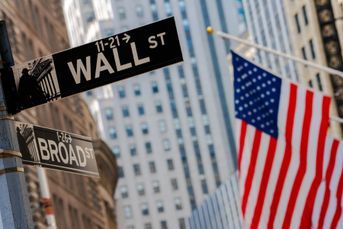Will Vanguard’s surge reignite ETF price war?
Index specialist's cheaper funds gaining fast on BlackRock, State Street; 'hard pill to swallow'
BlackRock Inc. and State Street Corp., the world’s largest sellers of exchange-traded funds, may be forced to cut fees as they lose assets to lower-priced competitors such as Vanguard Group Inc.
Vanguard’s U.S. ETFs pulled in a net $25.6 billion this year through Sept. 30, 26 percent more than BlackRock and State Street combined, according to Chicago-based Morningstar Inc. Vanguard last month offered 20 new ETFs, taking on the bigger companies for the first time with funds that track Standard & Poor’s and Russell indexes, including the S&P 500 Index.
Assets in exchange-traded funds, which trade through the day like stocks and mostly track indexes, rose almost 14-fold in the past decade to $897 billion, Morningstar data show. State Street and BlackRock dropped to a 70 percent combined share from 85 percent in 2005, as investors flocked to lower-fee funds from Valley Forge, Pennsylvania-based Vanguard, Charles Schwab Corp. and Pacific Investment Management Co.
“Cost isn’t everything, but it does matter,” said David Nadig, director of research for Index Publications LLC in Decatur, Georgia, which produces a website covering the ETF industry. “For the more competitive segment of the market, investors are voting with their feet.”
BlackRock, based in New York, jumped into ETFs with its $15.2 billion acquisition of Barclays Global Investors in December, which added the iShares funds. IShares has the biggest lineup of ETFs, with 462 funds, including 243 registered outside the U.S., and $412 billion under management as of Sept. 30.
Double the Fees
Fees charged by BlackRock and Boston-based State Street, which oversees $216 billion in ETFs, are on average about double those of Vanguard and Schwab of San Francisco.
The BlackRock iShares ETF that tracks the MSCI Emerging Markets Index manages $48.2 billion and has an expense ratio of 0.72 percent. That means an investor who puts in $10,000 would pay $72 annually in fund fees. The fund gathered $2.7 billion this year through Sept. 30, according to data compiled by Bloomberg.
The Vanguard ETF that follows the same benchmark has an expense ratio of 0.27 percent. Opened almost two years later than its iShares counterpart, the fund drew $13.3 billion this year and has climbed to $39.9 billion.
Vanguard, which has $126 billion in ETFs, is betting lower prices will help it catch its bigger rivals as exchange-traded funds continue to grow in popularity. ETFs are set to gather more deposits than index-based mutual funds this year. Through September, exchange-traded funds attracted $64.9 billion, compared with $55.7 billion for index funds, according to Morningstar.
Hedge Funds, Advisers
ETFs have caught on with financial advisers, who have adopted them as a cheap and easy way to spread clients’ money among various asset classes, industries and geographies. Hedge funds are another big customer, using them to trade quickly in and out of investments such as commodities and currencies.
IShares got into ETFs in 2000 and surpassed State Street as the No. 1 manager in 2003, overcoming State Street’s advantage of being earlier to market. That edge stemmed from investors favoring funds with more assets and higher trading volumes, which keep the spread between bid and ask prices narrower than on less liquid securities. IShares had net deposits of $15.1 billion this year through Sept. 30.
State Street opened SPDR S&P 500 ETF Trust, the first U.S. ETF, in 1993. It remains the largest ETF with $82.7 billion in assets, and State Street’s SPDR Gold Trust is the second biggest with $57 billion. The company has lagged behind iShares in more narrowly targeted ETFs, and it has 20 of its 114 funds registered outside the U.S. Investors put $5.2 billion into its ETFs this year.
Vanguard was initially reluctant to offer ETFs. Founder John Bogle repeatedly criticized the product for encouraging short-term investing. In 2001, a year after Bogle’s retirement, Vanguard introduced Total Stock Market ETF. Vanguard ETFs are separate share classes of the firm’s index mutual funds, a structure the company has patented.
BlackRock Rating Lowered
Vanguard expanded in 2004, rolling out 18 ETFs. It now runs 63. Like its mutual funds, Vanguard’s ETFs compete aggressively on fees, though they rarely went head-to-head on the same index with iShares or State Street, until September.
Following that move, Goldman Sachs analyst Marc Irizarry downgraded BlackRock on Oct. 5 to “neutral” from “buy,” citing “risks to iShare’s market share and fees amid rising industry price competition.”
BlackRock’s stock has lost 23 percent this year, compared with a decline of 8.5 percent by State Street. Vanguard, which isn’t publicly traded, is owned by its investors through their fund holdings.
BlackRock and State Street may eventually have to reduce expense ratios to hang onto investors.
‘Hard Pill’
“That’s a hard pill to swallow to cut fees, because you are literally throwing money away” in the short run, Nadig said in a telephone interview.
Schwab, the largest independent U.S. brokerage by client assets, opened its first ETFs in November. Its 11 funds have gathered a net $1.2 billion this year. Pimco, manager of the world’s biggest bond fund, opened its first in June 2009. The Newport Beach, California-based company’s eight index-based ETFs have collected $746 million this year.
Both iShares and State Street said they aren’t considering lowering expense ratios, except according to pre-set formulas that drop fees when the assets in a fund reach certain thresholds.
“We are absolutely sticking to our strategy,” iShares managing director Noel Archard said in an interview. “Our customers aren’t asking for lower expense ratios. They’re asking for more services.”
Those services include education on how to use ETFs, multi- ETF asset-allocation models and portfolio analysis, he said.
More Than Fees
Tony Rochte, a senior managing director at State Street’s money-management unit, said his customers see expense ratios as one of several elements in assessing whether to invest in a particular ETF. Just as important, he said, are liquidity, which can affect share prices; tracking error, measuring the accuracy with which an ETF follows its index; and tax-efficiency.
A frequent advantage for State Street and iShares, with their bigger funds, is liquidity. IShares’s $36.6 billion MSCI EAFE Index Fund tracking developed non-U.S. markets charges 0.35 percent and had an average bid-ask spread of 2 basis points, or 0.02 percentage points, during normal trading hours in the week ending Oct. 8, Bloomberg data show.
Schwab’s $357 million International Equity ETF, using the FTSE Developed ex-U.S. Index, is less than half the cost with an expense ratio of 0.13 percent. It’s average bid-ask spread was 13 basis points, or 0.13 percentage points.
Quote Spreads
“If the bid-ask spread is too large, perhaps because the fund is too small and liquidity is tight, you might end up paying more than you should, even if the underlying expense ratio is low,” said George Padula, a wealth-management adviser at Back Bay Financial Group Inc. in Boston, which oversees about $350 million, including $65 million in ETFs.
The more frequently an investor trades, the more likely a wider spread is to outweigh the benefits of a lower expense ratio. The most frequent traders are large institutional investors, Index Publications’ Nadig said. BlackRock and State Street are the world’s largest money managers for institutions.
Vanguard and Schwab, by contrast, cater mostly to retail investors, which may help them capture future ETF deposits.
Though none of the fund firms could provide a breakdown of ETF customers, iShares’ Archard, Rochte at State Street and Vanguard’s Francis Kinniry all said individuals, investing directly or through financial advisers, represented the fastest- growing investor segment.
A quarter of independent financial advisers said they intended to invest more in ETFs in the coming year, the highest of any investment vehicle, according to a July survey by Schwab.
“The biggest opportunity for growth is the changing landscape of advisers,” Kinniry, a member of Vanguard’s investment-strategy group, said. “Advisers used to use mutual- fund rotation. Now it’s asset allocation through ETFs.”
Learn more about reprints and licensing for this article.








